Best of Virunga National Park 2024 – Facts, Attractions, Lodges and More.
Virunga National Park is one of the few recognized UNESCO World Heritage Sites in Africa. Unlike other African safari parks, Virunga is the only national park where 3 Great Apes peacefully live. A visit to Virunga National Park on Congo tour is amazingly a lifetime opportunity to explore one of the world’s biodiverse conservancy/protected areas.
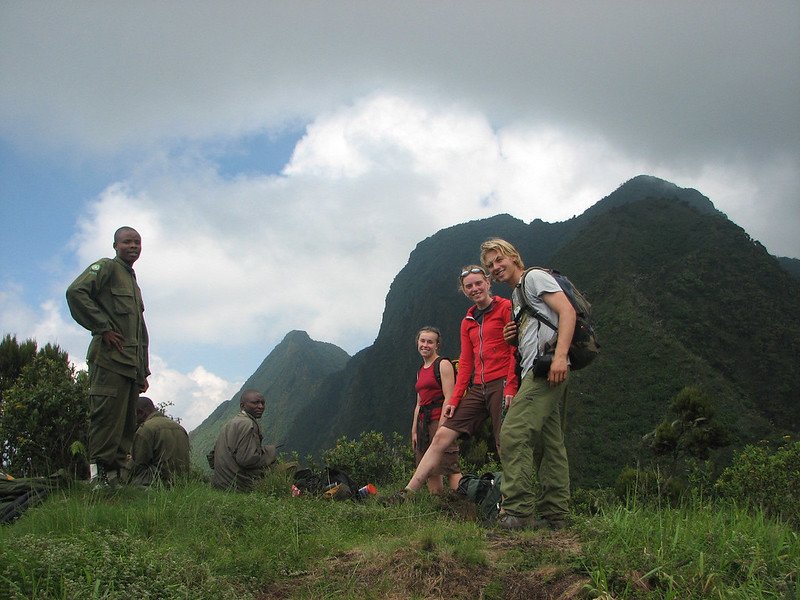
Geographical Location, size and formation;
Virunga National Park lies in the Eastern Democratic Republic of the Congo (DRC) within Virunga Conservation Area (VCA). Virunga was designated National Park status in 1925 and stands out as one of the oldest Parks on the African continent. Originally, Virunga and the present Volcanoes National Park in Rwanda were one block park. At the time, the two parks were referred to as Albert National Park.
Albert National Park happened to be the first Park to be established in Africa and the primary goal for its creation was to offer refuge to mountain gorillas. When the D.R. Congo and Rwanda attained their independence in the 1960s, they separated. Today, the two Parks stand as independent protected areas and most popular for mountain gorilla trekking experiences.
Virunga National Park is a vast Park with an area coverage of 7800sq.km and is the biggest of all the 4 protected areas where endangered mountain gorillas live. The Park lies at the heart of the Albertine rift and is bordered by Rwanda and Uganda. It extends from the Virunga Volcanoes (Massifs) in the South to the Rwenzori Mountains in the North.
Virunga’s Central sector is situated around Lake Edward, the Ishasha river valley and the Rwindi plains. The Southern section is most popular for its lush montane tropical forests, active Virunga volcanoes and the rare mountain gorillas which roam around the park’s flanks of Mount Mikeno.
Brief history of the Park.
When Virunga was first established, it occupied a compact area comprising of 3 Volcanoes in the South. Later, its area coverage was extended to encompass the Northern part also known as Rwindi Plains, Rwenzori Mountain ranges (Mountains of the Moon) and Lake Edward.
In 1969 after D.R. Congo attained its independence from the Belgium colonial government in 1960, this Park was renamed as Virunga National Park. After 10 years around 1979, this Park was recognized as UNESCO World Heritage Site. This Park has had several periods of conflict a factor that poses a huge challenge in its wildlife conservation.
Around 2008, the Congolese National Parks Authority, Institut Congolais pour la Conservation de la Nature –ICCN), and Virunga Foundation (African Conservation Foundation) came together so as to ensure proper management of the Park. The partnership was brought about a comprehensive reform program resulting into the Virunga Alliance, an innovative development programme aimed at addressing the root causes of poverty and conflict. The overall aim of the alliance is mainly to eradicate illegal and destructive resource extraction in the region.
Fauna and birdlife in the Virunga National Park
Virunga National Park is among the very few biodiverse protected areas on the African continent. Its biodiversity range in the diverse habitats. Virunga’s distinct habitats consist of swamps, savannas, lava plains and snow fields. Most of the Virunga Park habitats exist around the Virunga Massifs, Lake Edward, Rwenzori Mountains and flat plains around its volcanoes. Virunga prides itself of distinct landscape and a holiday here guarantees you plentiful of things to see and engage in.
Fauna/wildlife
A total of 218 mammal species call Virunga a home and a huge profusion of these range in the different habitats. The Park’s diverse mammals worth searching on Congo safari in Virunga Park include Uganda Kobs, African elephants, Aardvark, hippos, blue duikers, waterbucks, bongo, warthogs, giant forest hogs, tree pangolin, okapis, bush pigs, bushbucks, and more.
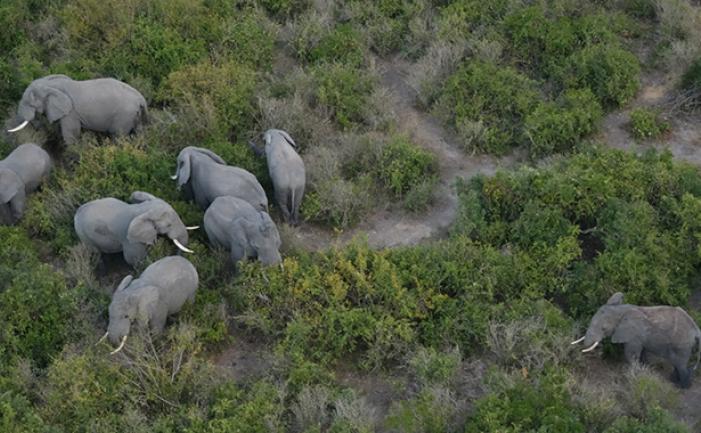
Diverse primate species also await you to encounter on primate tour in Virunga and include the Dent’s Mona monkeys, endangered mountain gorillas, red tailed monkeys, chimpanzees, De Brazza’s monkeys, Central African red colobus monkeys, Mantled Guereza, Hamlyn’s Monkeys, Grey-cheeked mangabeys, olive baboons and others.
Birdlife in the Virunga.
More than 706 avifaunal species also exist in the various habitats in Virunga National Park. These include abundant Congolese and Albertine rift endemic species which makes this park a special place to begin your birding excursion in the D.R. Congo. T
he avifaunal check list in Virunga National Park include the Mourning collared dove, red-necked spurfowl, red billed teal, Northern pintail, barred long-tailed cuckoos, Alpine swift, Mozambique Nightjars, black billed turacos, red knobbed coot, common redshanks, black bellied bustards, temminck’s courser, black winged stilt, green wood hoopoe, blue cheeked bee-eaters, white fronted plovers, black tailed Godwit, and brown throated wattle eye.
Other birds include white thighed hornbills, Montagu’s harrier, striped kingfishers, Wahlberg’s honey bird, lanner falcon, fawn-breasted shrike, spot flanked barbet, moustached grass warbler, yellow crested helmet shrike, petit’s cuckoo shrikes, cardinal woodpeckers, eastern mountain greenbul, African paradise flycatchers, spectacled weaver, Northern grey headed sparrow, brown crowned tchagra, cinnamon breasted bunting, mountain wagtail, snowy-crowned robin chat, bracken warbler, purple indigo bird, narrow tailed starling, and many others.
Flora in Virunga
Over 2077 species of plants are found in the Virunga National Park alone. These include over 264 species of trees, 230 plants which are Albertine rift endemic species. Majority of the park’s plant life dominate the wetlands and grasslands consisting of papyrus sedge, sacaton grasses, jointed grasses, common reed, conkerberry, and paper bark thorn, etc.
The people/Ethnic groups
The ethnic groups that live in and around Virunga include the Hutu, Tutsi, Mbuti and Basongora people.
Things to do in and around Virunga National Park;
Virunga has a range of safari activities for nature enthusiasts to engage in and include primate and volcano adventures. The notable things to do in and around this park include;
Gorilla trekking
Gorilla trekking is the first thing you must consider on your bucket-list of experiences to enjoy in Virunga National Park. This Park was initially created to protect mountain gorillas and with no doubt, visitors are guaranteed of exceptional encounters on their gorilla trekking adventures. About 8 gorilla families have undergone full habituation and now readily available for gorilla tourism.
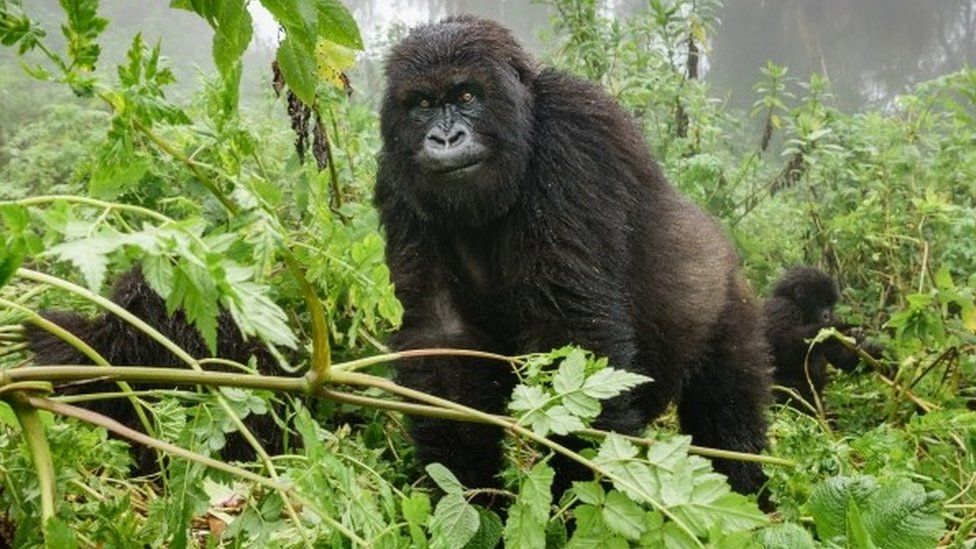
During the gorilla trekking adventure, visitors get briefed at Bukima and park ranger guides are allocated to lead you throughout. A maximum of an hour is what the park authorities allow you to spend face-to-face with a family of habituated mountain gorillas in the wild. The gorilla groups to explore in Congo’s Virunga Park include among others Humba, Kabirizi, Rugendo, Lulengo, Mapuwa gorilla group, Nyakamwe, Bageni and Munyaga.
You can only be allowed to visit a gorilla group in Virunga if you have a valid gorilla permit which is issued at USD 400 per person. A gorilla permit for gorilla safaris to Virunga National Park can be booked through a trusted tour operator.
Essentials you shouldn’t leave out of your gorilla trekking packing list include long-sleeved shits, cameras, extra batteries, a pair of binoculars, snacks, waterproof hiking boots, daypack,
Birding
Virunga National Park is significant birding destination which guarantees you plenty of birds to sight. On birding excursion, expect to encounter myriad of Albertine rift endemic species such as the Rwenzori turacos, Archer’s ground robin, collared apalis, Kivu ground thrush, Shelley’s crimson wings, mountain masked apalis, blue headed sunbird, Rwenzori double-collared sunbird, strange weaver bird, stripe-breasted tit, and regal sunbird.
There are also countless non-endemic species worth spotting and include the blue spotted wood dove, African goshawk, Wahlberg’s eagle, black billed turacos, common buzzard, harrier hawks, red-chested cuckoos, mountain oriole, white eyed slaty flycatchers, tambourine dove, green sandpiper, Doherty’s bush shrike, cinnamon chested bee-eaters, Klaas’s cuckoos, African olive pigeon, black and white casqued hornbills, Alpine swift, white browed crombec, black headed waxbills, mackinnon’s shrikes, grassland pipit, chin spot batis and more.
Volcano hiking/climbing
Virunga is a preferred destination not only for birding or mountain gorillas but also exhilarating Volcano hikes. The Park lies within the Virunga Area and this region features 8 Virunga Massifs.
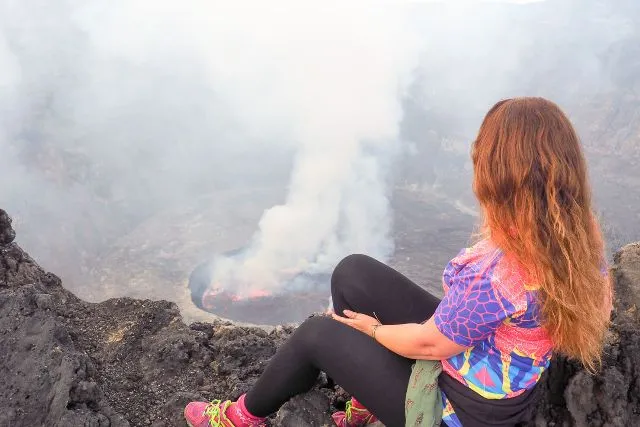
On volcano hiking adventure, you can explore the powerful Nyiragongo Volcano. The hikes to the summits of Nyiragongo (3470m) starts at Kibati with an experienced guide leading you through. Besides Nyiragongo, there are other two incredible volcanoes found in Virunga National Park and include Mount Nyamuragira and Mikeno.
Nature walks
A guided nature walk in the Virunga is such an unusual experience. It is the best way to get close to nature and you get to explore in depth the hidden gem. On a guided nature walk, you can easily come across primates and birds.
Chimpanzee tracking/habituation
Chimpanzee encounters also await you on Congo tour in the Virunga National Park in D.R. Congo. This primate adventure began in 1987 by Frankfurt Zoological Society and it was purposely introduced for research studies. Visitors get a chance to explore chimp community in the rainforest and a chance to take their photos.
When to visit Virunga National Park in the D.R. Congo?
Virunga National Park lies in the Albertine rift area, an area that is influenced by the movement of the Intertropical Convergence Zone and EI Nino-Southern Oscillation. The ideal period for you to excellently enjoy adventures like gorilla trekking in Virunga National Park is during the dry season. The dry months occur from December to February and June to August. The rainy months run from March till May, September to November.
The savanna area around Lake Edward receives rainfall range of 30mm to 40mm and is the driest section of Virunga. The Northern sector experiences monthly mean precipitation of 220mm while the Southern end records precipitation of 160mm. The average temperature record along the lower elevation differs from 23 to 28 degrees while in higher altitudes, about 16-24 degrees but can drop even below 14 degrees celsius.
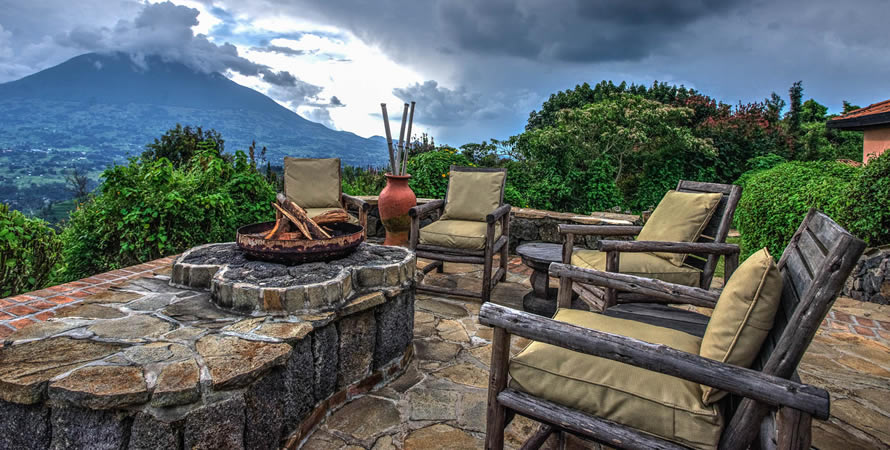
Accommodation
Top accommodation options to consider for your stay after or before engaging in your adventures in Virunga National Park include Lulimbi Tented Camp, Mikeno Lodge, Tchegera Island Camp, Bukima Tented Camp, Kibumba Tented Camp and Mount Nyiragongo Summit Shelters.
Getting to the Virunga National Park
Visitors intending to spend their next holiday in Virunga can reach the park by road or air. By road, you can set off from Rwanda via Gisenyi then to Goma town in the D.R. Congo or drive off from Kisoro in Southwestern Uganda to Bunagana border then to Bukima where gorilla treks begin from Virunga National Park.
By air, you can fly direct to Goma airport. From Goma, you can easily connect up to the Park in the shortest period possible.
